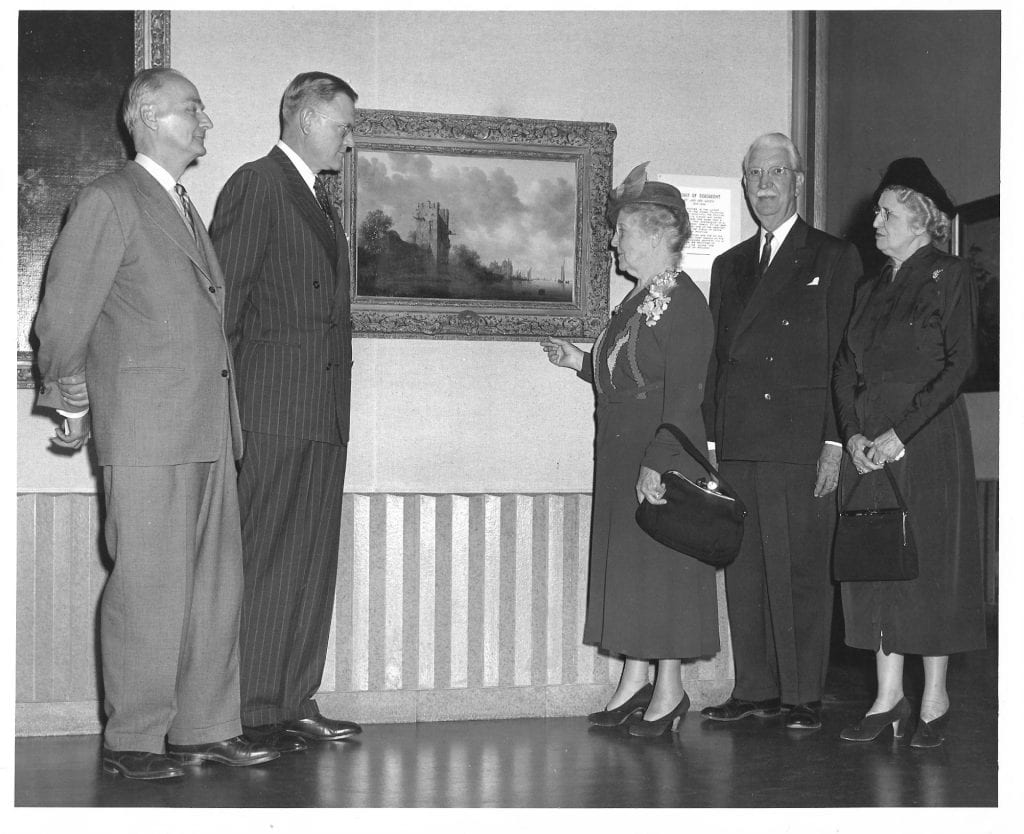
In 1937, the University of Southern California accepted a gift from Elizabeth Holmes Fisher to construct what is now known as the USC Fisher Museum of Art, dedicated on November 14, 1939. In addition to founding the museum, Mrs. Fisher gave the University a significant portion of her art collection. Between 1939 and 1951, Mrs. Fisher donated a total of 74 paintings, drawings, and sculptures by European and American artists. The Elizabeth Holmes Fisher Collection comprises 19th-century American Hudson River School and French Barbizon landscapes; 17th and 18th-century British portraits; and Dutch and Flemish masterworks from the 16th through 18th centuries. Close to one-third of the entire Fisher Collection is devoted to 16th and 17th-century European masters, namely Dutch, Flemish, German, and French. The collection contains representative forerunners from the “golden age” in each of four areas of painting: portraiture, landscape, history, and genre.
Mrs. Fisher’s dream of having her collection act as a nucleus to attract other donations was realized in 1965, when Armand Hammer donated 48 paintings to the Museum. Hammer began collecting art in the 1920s with the purpose of decorating his Moscow home. At first, he collected with his brother, Victor Hammer. Following their return to the United States, the brothers established the Hammer Galleries in New York City. In 1958, Hammer showed his collection at the Municipal Art Gallery in Los Angeles and announced his intention to donate the collection to a public institution. Between 1963 and 1974, Hammer donated a collection of works by Dutch, Flemish, German, and Italian masters of the 15th through 17th centuries.
Under the leadership of former gallery director Dr. Selma Holo, the greatest area of growth in recent years is in the 20th and 21st-century collections, achieved through the generosity of donors and through purchases made by the Museum. The contemporary collections are concentrated in the media of painting, prints, drawings, and photography. They mainly feature works by California artists, but also include an emphasis on international art, especially that of Mexico and Spain.
In 2015 pioneering Beverly Hills AIDS doctor, Dr. Eugene (Gene) Rogolsky, donated his collection of more than 700 works to the USC Fisher Museum of Art. Dr. Rogolsky’s collection is a complex, unorthodox, and introspective one, where photographs, prints, paintings, and sculptures range from sacred to profane, local to international, cerebral to prurient. Present in the collection are Czech artists, American photographers, and many local Los Angeles artists. While the collecting pattern is mostly a single work per artist, there are some who make their mark in the collection by virtue of a wider range of examples—famed Chicano artist Carlos Almaraz, for example, with 55 works.
Today, the USC Fisher Museum of Art maintains a permanent collection of approximately 3,286 works of art, ranging from old-master paintings to contemporary works dating from 1500 to the present day. The collection comprises works by European and American artists working principally in painting, printmaking, drawing, and photography, along with a number of sculptures and decorative art objects.
The USC Fisher Museum also oversees pieces of public art and sculpture located in front of the Museum’s entrance on Exposition Boulevard. These works contribute to the visual and cultural landscape of the USC campus, providing opportunities for reflection, interaction, and engagement, and are subject to the same procedures and policies as the rest of the museum’s collections.